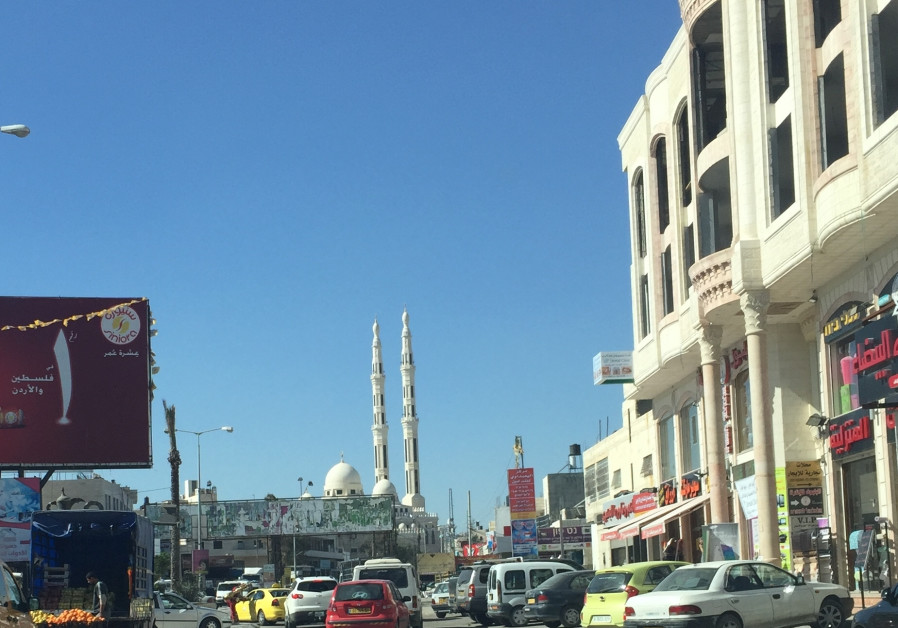A tour of Abu Dis, the proposed capital of a future Palestinian state

ABU DIS. Not really a town but an endless series of suburbs and ill-maintained roads, alleys and villages that have all become one.. (photo credit: SETH J. FRANTZMAN)
The return of Abu Dis to the center of discussions about a proposed capital of a Palestinian state conjures up memories of the 1990s for some.
Back in 1996, construction began on a massive 1,717-sq.m. building just outside of Jerusalem that was supposed to be the Palestinian Legislative Council.
There was even a large window that Yasser Arafat wanted so he could look out over Jerusalem from Abu Dis.
Since December of last year, there have been rumors that the Abu Dis plan was back in the cards. This envisions the congested suburb becoming the capital of a Palestinian State.
To understand what Abu Dis is, we need to take a tour of it. It’s the closest point to Jerusalem that is under a form of Palestinian Authority control. It is outside the security wall Israel built in 2003.
Abu Dis itself sits on a line of hills that are only a kilometer from the Old City. Just north of Abu Dis is the tomb of Lazarus, a Christian site with a picturesque church that sits over the tomb. This area, called Azariya in Arabic and Bethany in the New Testament, has a warren of smaller and narrow streets and is a minor tourist attraction.
The rest of the neighborhoods around Abu Dis are all built informally without any planning, with large family homes perched on the dry hills and valleys that fall away to the east toward the Dead Sea.
Today, Abu Dis is a backwater that links the Palestinian areas of the north and south parts of the West Bank. It has a university campus and popular Arab Bank branch, simple shops and not much else. It’s a stop for locals or those making a trip somewhere else.
To get to Abu Dis, Palestinians would have to drive from either Bethlehem or Ramallah.
United States Agency for International Development invested in some of the roads to and from Abu Dis. In 2009 USAID helped pay for the paving of Abu Dis’s internal roads and in 2013 the Sheikh Sa’ad road of nearby al-Sawahira was paved and renovated.
Nevertheless, from Abu Dis to Bethlehem is a trek via a circuitous road that runs over hills and wadis toward Beit Sahur. It meanders near the Jewish community of Kedar and there is an Israeli security checkpoint along the way that isn’t vigorously manned often but would allow the road to be closed, cutting off Abu Dis from the southern West Bank.

To get to Abu Dis from Ramallah is an even longer trip. One has to drive next to Ma’aleh Adumim and then down to Route 1, before taking Route 437 up to Hizma and then around Geva Binyamin – through the massive traffic jam – and into Ramallah.
Yet, the Palestinians chose this site in the ’90s during the Oslo Accords, when many of the Jewish communities in the area were smaller and they still had hopes some kind of contiguous West Bank would become a Palestinian state. Abu Dis was not yet an island nor was it walled off from Jerusalem.
Today it is entirely different. Now, if you want to get to Abu Dis from Jerusalem, you have to drive out toward Ma’aleh Adumim and then drive through Azariya.
The town of Abu Dis isn’t really a town but an endless series of suburbs and ill-maintained roads, alleys and villages that have all become one. There’s little infrastructure or thought given to any of the development and scant investment in infrastructure either. Any investment the city receives goes into Al-Quds University, the large campus compound in Abu Dis that serves thousands of students.
The campus is pretty and has new buildings. It even houses the Abu Jihad Museum, which is devoted to Palestinian prisoners, and which was funded by Kuwait.
In Azariya there is the new Sheikh Khalifa bin Zayed al-Nahyan Mosque that can accommodate 6,000 worshipers and was completed in 2014 with funds from the United Arab Emirates. But there’s little investment so far for the Palestinian governing institutions that supposedly would festoon the area. The only piece of the Palestinian government in Abu Dis is the large parliament building, which was built in the 1990s but was never completed.
In 2015, The Guardian got access to the Palestinian legislative building and called it a “hulking skeleton” and emblematic of the “dysfunction” of the region. But perhaps it’s more like a testament to a failed peace plan that had more chance of success in the 1990s than it does today.
It’s not clear whether Palestinians want the Palestinian Authority to move to Abu Dis or how they would go about with the move. It’s also not clear that Israel would allow Abu Dis to become a flourishing capital or administrative center.
The area is already tied up in endless traffic jams of people traveling to the university or traversing it to get from Ramallah to Bethlehem. It simply can’t support more traffic. USAID, which has built some of the roads near Abu Dis, might be enlisted to do some more if the plan comes together.





Comments are closed.